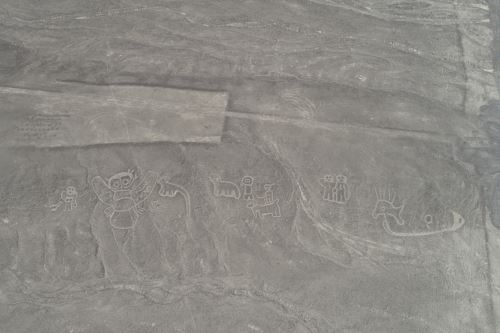16:55 | Palpa (Ica region), Feb. 3.
"The Orca of Big Stones," "The Shaman and his Allies," and "Animals from the desert and where to observe them" are the three groups of impressive geoglyphs based in Ica region, which were presented on Monday by Peru's Culture Ministry after having executed enhancement works in the area.
The aforementioned groups of geoglyphs are part of a cultural tourist circuit located in the province of Palpa, and it was inaugurated by the corresponding Ministry authorities on the occasion.

The three groups of geoglyphs feature various anthropomorphic and zoomorphic figures of different dimensions, which are detailed below: The first one —also known as "The Shaman and his Allies"— comprises a central character representing an anthropomorphic or shaman character that is located in a central position surrounded by animals like the killer whale and monkey figures. It is believed to have supernatural attributes, and the animals surrounding the subject are linked to water, as well as to fertility.
The "Animals from the desert and where to observe them" group is characterized by the presence of a series of animals, among which the figures of an owl, two camelids, a feline, and several anthropomorphic characters —all of different sizes— stand out. Together, they occupy an area of about 20 meters high by 165 meters long (seen horizontally).
"The Orca of Big Stones" represents one of the most important mythical beings of Paracas and Nazca societies, which is usually portrayed featuring human attributes (it has a human arm carrying a trophy head). The figure is facing west (where the ocean is located). Additionally, it has the figure of a fish in front of the mouth and several human heads inside the body. This figure is 25 meters high and 65 meters long.
The works carried out are part of the activities led by the Culture Ministry's Nazca–Palpa Management, which aimed to carry out cleaning, conservation, and enhancement of geoglyphs in the aforementioned area.
This way, not only research, conservation, and protection of geoglyphs are promoted, but also the development of related activities for the benefit of the local and regional population.
The ceremony was attended by Culture Minister Sonia Guillen, Chief of the Decentralized Directorate of Culture of Ica Ana Maria Ortiz de Zevallos, Chief of the Directorate of World Heritage Sites Ana Maria Hoyle Montalva, and the Chief of the Nazca-Palpa Management Plan Johny Isla Cuadrado.
About
Located in the arid Peruvian coastal plain, some 400 km south of Lima,
the Lines and Geoglyphs of Nazca and Pampas de Jumana are one of the most impressive-looking archaeological areas in the world and an extraordinary example of the traditional and millenary magical-religious world of the ancient pre-Hispanic societies which flourished on the Peruvian south coast between the 8th century B.C. and the 8th century A.D.
They are located in the desert plains of the basin river of Rio Grande de Nazca, the archaeological site covers an area of approximately 75,358.47 ha where for nearly 2,000 uninterrupted years, the region's ancient inhabitants drew on the arid ground a great variety of thousands of large scale zoomorphic and anthropomorphic figures and lines or sweeps with outstanding geometric precision, transforming the vast land into a highly symbolic, ritual and social cultural landscape that remains until today.
They represent a remarkable manifestation of a common religion and social homogeneity that lasted a considerable period of time.
They are the most outstanding group of geoglyphs anywhere in the world and are unmatched in its extent, magnitude, quantity, size, diversity, and ancient tradition to any similar work in the world, according to UNESCO.
(END) GBL/MAO/MTS/MVB
Published: 2/3/2020